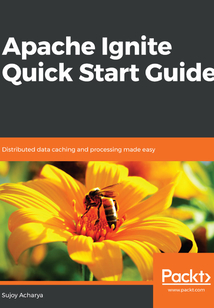舉報(bào) 

會(huì)員
Apache Ignite Quick Start Guide
ApacheIgniteisadistributedin-memoryplatformdesignedtoscaleandprocesslargevolumeofdata.Itcanbeintegratedwithmicroservicesaswellasmonolithicsystems,andcanbeusedasascalable,highlyavailableandperformantdeploymentplatformformicroservices.ThisbookwillteachyoutouseApacheIgniteforbuildingahigh-performance,scalable,highlyavailablesystemarchitecturewithdataintegrity.ThebooktakesyouthroughthebasicsofApacheIgniteandin-memorytechnologies.YouwilllearnaboutinstallationandclusteringIgnitenodes,cachingtopologies,andvariouscachingstrategies,suchascacheaside,readandwritethrough,andwritebehind.Next,youwilldelveintodetailedaspectsofIgnite’sdatagrid:websessionclusteringandqueryingdata.YouwilllearnhowtoprocesslargevolumesofdatausingcomputegridandIgnite’smap-reduceandexecutorservice.YouwilllearnaboutthememoryarchitectureofApacheIgniteandmonitoringmemoryandcaches.YouwilluseIgniteforcomplexeventprocessing,eventstreaming,andthetime-seriespredictionsofopportunitiesandthreats.Additionally,youwillgothroughoff-heapandon-heapcaching,swapping,andnativeandSpringframeworkintegrationwithApacheIgnite.Bytheendofthisbook,youwillbeconfidentwithallthefeaturesofApacheIgnite2.xthatcanbeusedtobuildahigh-performancesystemarchitecture.
目錄(152章)
倒序
- coverpage
- Title Page
- About Packt
- Why subscribe?
- Packt.com
- Contributors
- About the author
- About the reviewer
- Packt is searching for authors like you
- Preface
- Who this book is for
- What this book covers
- To get the most out of this book
- Download the example code files
- Download the color images
- Conventions used
- Get in touch
- Reviews
- Getting Familiar with Apache Ignite
- Why Apache Ignite?
- Exploring the features
- In-Memory Data Grid (IMDG)
- In-Memory SQL Grid (IMSG)
- Compute Grid
- Service Grid
- Streaming and Complex Event Processing
- Ignite File System (IGFS)
- Clustering
- Messaging
- Distributed data structures
- Refactoring the architecture
- Achieving High Performance
- Addressing High Availability and Resiliency
- Sharing Data
- Moving Computation To Data
- Installing Apache Ignite
- Running HelloWorld
- Classifying Apache Ignite
- IMDB versus IMDG
- YugaByte DB
- Geode Hazelcast Redis and EhCache
- Summary
- References
- Understanding the Topologies and Caching Strategies
- CAP theorem and Apache Ignite
- Clustering architecture
- Node discovery
- TCP/IP discovery
- ZooKeeper discovery
- Node deployment
- Cluster grouping
- All nodes
- Remote nodes
- Cache nodes
- Grouping by attributes
- Grouping by node age
- Local nodes
- Client and server nodes
- Custom nodes
- Caching topology
- Local
- Partitioned
- Replicated
- Caching strategy
- Cache aside
- Read-through and write-through
- Write-behind
- Summary
- Working with Data Grids
- Exploring the Data Grid
- Viewing cache elements
- Configuring the DataGrid
- Configuring Ignite caching
- Configuring L2 Caching
- Web session clustering
- How did it work?
- Summary
- Exploring the Compute Grid and Query API
- Query API
- ScanQuery
- TextQuery
- SqlQuery
- Collocated
- Annotation-based query
- Field based query
- Non-collocated
- SQL functions
- Compute Grid
- Distributed Closure
- Broadcasting asynchronously
- Exploring the run and call APIs
- Exploring the apply API
- Ignite MapReduce/ForkJoin
- Task Adapter
- Task Split
- Task Sessions
- Ignite Executor Service
- Ignite Job Scheduler
- Ignite AOP
- Summary
- Building MicroServices with Service Grid
- Understanding the service grid
- Deploying microservices on Ignite
- Building microservices
- Processing complex events
- Streaming events
- Summary
- Sharpening Ignite Skills
- Writing data to a persistent store
- Enabling native persistence
- Persisting data to MySQL
- Persisting data to Cassandra
- Working with the POJO strategy
- Working with the BLOB strategy
- Processing transactions
- Exploring transactional mode
- Transaction concurrency and isolation
- Exploring distributed data structures
- CountDownLatch
- Semaphore
- ID generator
- Queue and Set
- Atomic types
- IgniteAtomicLong
- IgniteAtomicReference
- IgniteAtomicStamped
- Summary
- Deploying To Production
- Understanding the memory model
- Retrieving a value
- Storing an entry
- Preventing OOM
- Off-heap eviction
- RANDOM_LRU
- RANDOM_2_LRU
- On-heap eviction
- LRU
- FIFO
- SORTED
- Swap space
- Expiring entries
- Monitoring memory and caches
- Memory region monitoring
- Cache monitoring
- JMX console monitoring
- Securing data
- Tuning performance
- Exploring the deployment options
- Summary
- References
- Other Books You May Enjoy
- Leave a review - let other readers know what you think 更新時(shí)間:2021-06-10 18:52:51
推薦閱讀
- ABB工業(yè)機(jī)器人編程全集
- Mobile DevOps
- Getting Started with Containerization
- OpenStack Cloud Computing Cookbook
- Deep Reinforcement Learning Hands-On
- Hands-On Data Warehousing with Azure Data Factory
- 基于ARM9的小型機(jī)器人制作
- Excel 2007終極技巧金典
- 中文版AutoCAD 2013高手速成
- 空間機(jī)器人智能感知技術(shù)
- 案例解說(shuō)Delphi典型控制應(yīng)用
- Machine Learning with Spark(Second Edition)
- 菜鳥起飛電腦組裝·維護(hù)與故障排查
- 大型機(jī)系統(tǒng)應(yīng)用基礎(chǔ)
- JSP通用范例開發(fā)金典
- 軟測(cè)之魂
- CPLD/FPGA技術(shù)應(yīng)用
- 電機(jī)與電力拖動(dòng)
- Mastercam X5應(yīng)用技能基本功特訓(xùn)
- ASP.NET學(xué)習(xí)手冊(cè)
- Hands/On Kubernetes on Azure
- Linux應(yīng)用程序設(shè)計(jì)
- TensorFlow深度學(xué)習(xí)應(yīng)用實(shí)踐
- Learning QGIS(Third Edition)
- Implementing Cisco UCS Solutions(Second Edition)
- Hands-On Data Science with Anaconda
- Raspberry Pi Zero Cookbook
- Illustrator CS6完全自學(xué)經(jīng)驗(yàn)分享
- Arduino創(chuàng)意機(jī)器人入門
- Build Supercomputers with Raspberry Pi 3

